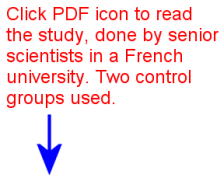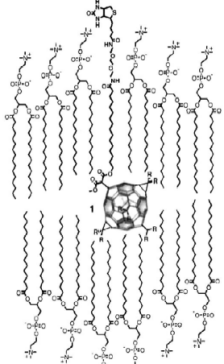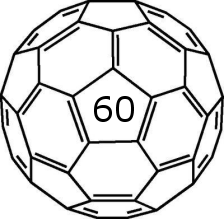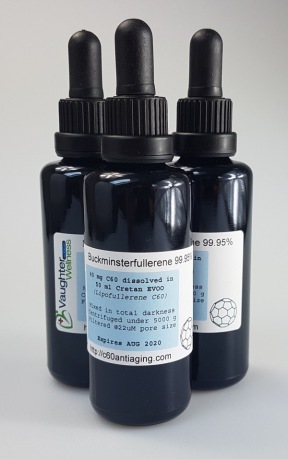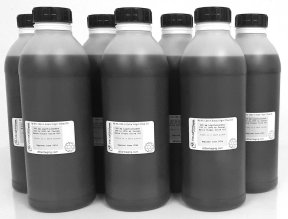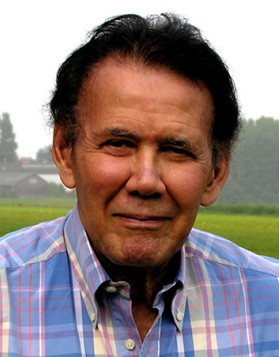What is the cost of producing buckyballs in olive oil?
This article was written in 2012. We use solvent-free C60 from Solaris now.
The cost of ingredients for a C60-oilive oil solution, even when prepared exactly as in the original rat study, seems much smaller than the retail price.
But that's not because of price-gouging, it is because the production process is extremely cumbersome, apart from using expensive lab equipment and disposables such as microfilters and centrifuge bottles ($300 for twelve 750 ml bottles).
Sublimated Buckminsterfullerene with a purity between 99.97 and 99.99% costs us in excess of 100 dollars a gram.
But the main reason for the relatively high price is the very laborious production process.
This product will likely never be produced on an industrial scale by the pharmaceutical industry or by some large supplements manufacturer, having equipment costing hundreds of thousands of dollars at their disposal. We do everything by hand. A breakdown of the cost of manufacturing:
- Extra virgin olive oil of the finest quality. Cost: $1 per 50 ml bottle.
- Sublimated C60 with a purity of 99.97 to 99.99%. Cost : $5 per 50 ml bottle. There are Russian suppliers that sell much cheaper C60 but it is toxic garbage, see our article on the Russian fullerene mafia.
- The glass dropper bottle itself. Cost: $1.
- Label and heat shrink seal: $0.2.
- Lab consumables (gloves, mouth masks, electricity, 0.22 ?m filters, worn out centrifuge bottles - a bottle's contents weighs in excess of 3000 kilo during an hour of spinning at 5000 g): $1.
The cost of the lab equipment itself is considerate, even though we purchased the most expensive item, the centrifuge, used.
We wanted to do things properly so we will use a hot air sterilizer for the bottles and a microscope to verify that there was no particle leakage around the filter. We also heat-seal the bottle caps.
It does not look like the whole world is going to try this relatively expensive product, so we can't count on massive sales. In addition, the very expensive centrifuge will not last forever, especially not considering the fact that it must run one hour at top speed for just 60 bottles. Neither will the electric vacuum pump for the filtration units or the magnetic stirrers, that are on 24/7: Two weeks of stirring for each C60-oil mixture.
We estimate the total material cost of producing a bottle with 50 ml of C60-oil to be around ten dollars.

100 grams of 99.9% C60 costs $3800, which is about 75% the price of gold at the time of writing.
But the cost of labor is substantial, and the yield of the laborious production process is low.
First, the bottles have to be sterilized. Some of our competitors use plastic bottles, which is bad because plastic may release volatile substances that may react with the C60, and plastic bottles can't be sterilized.
Then the C60 has to be stirred for two weeks. We have eleven stirrers in operation, each stirring away at 3.5 liters of product. That allows us to produce a maximum of 1540 bottles a month, just 50 bottles per day. You understand that when you have to set up a lab and hire someone to staff it full-time (mixing, sterilizing, centrifuging, filtering, filling, labelling, sealing, dispatching) that a maximum of 50 sales a day is not very economical. The cost of hiring a skilled lab worker part-time is approx. $2000 per month including taxes. It has to be a responsible person, understanding the dangers of unbalanced loads in centrifuges and the possible imploding of vacuum-pulled glassware, someone with the discipline to work sterilely and not cut corners by forgetting to filter or centrifuge a batch.
So that adds two more dollars to the cost of producing the bottles. A problem with the efficient production of C60-in-oil solution is the fact that you need to use more C60 than can dissolve in the oil, and that quite a bit is lost as sediment in the centrifuge bottles or on the filter.
And then there is web hosting, customer support, the cost of advertising, payment processor fees, the risk of shipments lost in the mail and last but not least taxes. All in all, the raw cost to us of producing and selling those 50 ml bottles are around 16 dollars per bottle. That is extremely expensive, if you realize that cosmetics that sell for 30 dollars cost much, much less than 3 dollars to make. The markups in the supplements space are outrageous. No health supplements manufacturer would even consider entering a market where the cost of production for a unit is in the double digits. Not profitable enough. That is why we know there won't ever be serious competition, apart from basement setups by hobbyists.


